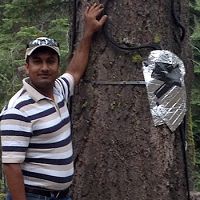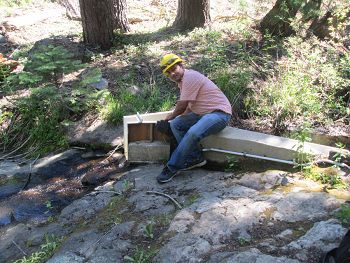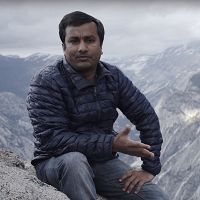Critical Zone Profile - MOHAMMAD SAFEEQ (hydrologist, assistant research scientist)
Mohammad Safeeq is a research hydrologist working in the Kings River Experimental Watershed and Southern Sierra CZO, located in California's Southern Sierra Nevada Mountains. The hydrology of the Sierra Nevada Mountains is critical to sustaining California’s water supply. Climate change and forest disturbances pose a threat to the availability and quality of water for domestic use, forests, agriculture, and ecosystems in the state.
Complex interactions between climate, vegetation, soil, rock, and other living organisms in the critical zone regulate the magnitude and timing of recharge, movement, storage, and delivery of water downstream. Safeeq studies how climate, vegetation, geology, and soil characteristics control and modulate critical zone processes related to water. The goal of Safeeq’s research is to identify key hydrologic controls for quantifying and predicting the impacts of climate change on California’s future water supply.
Snow depth, soil moisture, metric potential, and sap flux data are collected in and around this tree in the Southern Sierra Critical Zone Observatory to monitor and characterize individual-tree level water use patterns.
"The critical zone is fundamental to all life on Earth. Understanding the critical zone is the first step in developing science-based, targeted land management and restoration strategies.” – Mohammad Safeeq
I was born and raised in a farming family in the Gangetic plain of Northern India, which is known for its intensive agriculture. As a child, growing up in this environment gave me a deep sense of appreciation for nature and for the value of the critical zone in sustaining humans and other forms of life. Farms are typically places where people interact with and manipulate the critical zone on a daily basis—both in constructive and damaging ways. The biggest change that I have seen in my lifetime is the shift in farming practices, from traditional ecosystem-based to modern enterprise-based agriculture, and the associated increase in the extent of soil and water degradation around the globe.
I graduated with a degree in Agricultural Engineering and went on to get a PhD in Natural Resources and Environmental Management. In terms of my research career, I started as an agricultural hydrologist but now I am mostly focused on watershed and regional-scale hydrology and hydro-climatology. Recently, I have been collaborating with scientists from a wide range of disciplines, including meteorology, ecology, forestry, and geology. This interdisciplinary collaboration requires integration of my hydrologic knowledge with other physical, ecological, and economic considerations that are beyond my area of expertise. I have learned to listen to and work collaboratively with these other experts.
My current research explores how climate, vegetation, geology, and soil characteristics control and modulate critical zone processes related to movement, storage, and delivery of water. Climate change and forest disturbances directly and indirectly affect the structure and function of forest ecosystems – impacting their ability to provide ecosystem services such as clean water, habitat, recreation, timber, and carbon storage. Quantifying the magnitude, location, and extent of current and future changes in ecosystem services is essential for developing targeted management and restoration strategies.
Specifically, I study how changes in climate and vegetation affect canopy water balance and runoff under different climate regimes and across different landscapes. I perform in-situ measurements of air and water temperatures, solar radiation, wind speed and direction, humidity, precipitation, snowfall, soil moisture, and streamflow. I also monitor water flow and storage within the tree canopy – in leaves, branches, and stems. These measurements can be used to quantify the amount of precipitation that never hits the ground and returns to atmosphere through direct evaporation from the canopy.
These in-situ measurements also help in validating remote-sensing based measurements and numerical models that are increasingly important in understanding, modeling, and forecasting of hydrologic processes. The coupling between hydrological and ecological functions has been studied at a few well-instrumented sites, but there is a growing need to understand the relationship between these functions at watershed and regional scales. Recent advances in remote sensing technologies and in fine-scale data acquisition allow us to characterize changes in vegetation in a way that was nearly impossible in the past. With the help of numerical modeling and remote sensing, we can make accurate watershed- to regional-scale predictions about water and related ecosystem services.
Checking a small flume installed in the Kings River Experimental Watershed (KREW) for discharge measurement. A total of ten headwater catchments are instrumented within the KREW for monitoring ecosystem response following forest restoration and fuels reduction treatments.
The following are some of the scientific and management questions that I hope to answer in order to better manage natural resources, such as soil, water, and vegetation, more effectively and efficiently:
- How do different landscapes respond to climate change and forest disturbances?
- Is one watershed more resilient to climate change and forest disturbances than another?
- Can we manage forests to negate the effect of climate change on water?
- What are the spatial and temporal scales at which the feedbacks between geology, climate, and vegetation become apparent?
- Are there ways to generalize local findings in to a coherent conceptual model for making future predictions?
Networking with other CZO researchers is immensely helpful because we share our findings and learn from one another’s challenges and successes. Individually and collectively, we must continue to look for ways to communicate with policymakers and with the public about the societal relevance of CZO science. I have been and continue to be very vocal about the opportunities that CZOs provide for community education and outreach.
:: By Linda Copman, staff writer ::
Snow depth, soil moisture, metric potential, and sap flux data are collected in and around this tree in the Southern Sierra Critical Zone Observatory to monitor and characterize individual-tree level water use patterns.
Checking a small flume installed in the Kings River Experimental Watershed (KREW) for discharge measurement. A total of ten headwater catchments are instrumented within the KREW for monitoring ecosystem response following forest restoration and fuels reduction treatments.
Related News
Explore Further







